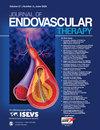摘要
目的:评估颅动脉疾病的金标准成像模式是数字减影血管造影术(DSA)。通过 DSA,操作者可以估计狭窄的直径和程度,并确定球囊的直径。由于这些测量值都是估算值,因此存在观察者之间和观察者内部的差异。本研究旨在确定评估硬脑膜血管造影的观察者间和观察者内的变异性:方法:7 名评估者(包括 3 名血管外科住院医师和 4 名血管外科医生)在 3 个不同的场合共进行了 15 次血管造影,并给出了相应的患者特征。评估人员提出了一系列问题,包括血管识别、估计直径、估计狭窄程度、治疗决定以及将使用哪种类型的球囊或支架(包括直径)。主要结果是动脉估计直径、估计狭窄程度和治疗决定的观察者间和观察者内变异性。次要结果是血管识别和如何治疗病变。使用类内相关系数(ICCs)和休伯特卡帕(Hubert's kappa)计算观察者间和观察者内的一致性,一致性差(.90)为不一致:在估计血管直径方面,观察者间的一致性为中等(0.62);在血管狭窄程度方面,观察者间的一致性为中等(0.72);在医生是否会治疗血管狭窄方面,观察者间的一致性为中等(0.53)。在球囊直径方面,观察者之间的一致性较差(0.21)。在估计血管直径方面,观察者内部的一致性从中等到良好(0.62-0.80)不等,在估计狭窄程度方面,观察者内部的一致性良好(0.76-0.87)。在治疗决定方面,观察者内部的一致性从中等到良好(.76-.87)不等,而在球囊直径方面则从差到中等(.07-.57)不等:本研究显示,在估计血管直径方面,观察者之间的一致性为中等,观察者内部的一致性为中等至良好。此外,在治疗决策方面,观察者内部的一致性为中度到良好,观察者之间的一致性为中度。该研究还显示,在球囊大小方面,观察者之间和观察者内部的一致性均为较差到中等。需要更客观的诊断方法来评估椎管病变的直径和形态:临床影响:数字减影血管造影术(DSA)是目前指导膝下经皮腔内血管成形术(PTA)的黄金标准成像模式。由于 DSA 缺乏客观测量,医生只能估计血管直径和狭窄百分比。本研究表明,DSA 的评估存在观察者之间和观察者内部的差异,这表明需要客观的成像模式来指导膝下 PTA。Objective: The gold standard imaging modality for assessing crural arterial disease is digital subtraction angiography (DSA). Using DSA, the operator can estimate the diameter and degree of stenosis and determine the diameter of the balloon. Since these measures are estimates, it allows for interobserver and intraobserver variability. This study aimed to determine the interobserver and intraobserver variability in the assessment of crural angiography.
Method: A total of 15 angiographies with corresponding patient characteristics were presented to 7 assessors, including 3 vascular surgery residents and 4 vascular surgeons on 3 separate occasions. A series of questions was presented, including vessel identification, estimated diameter, estimated degree of stenosis, treatment decision, and which type of balloon or stent would be used including diameter. The primary outcomes were interobserver and intraobserver variability in the estimated diameter of the artery, the estimated degree of stenosis and treatment decision. Secondary outcomes were vessel identification and how the lesion would be treated. Interobserver and intraobserver agreement was calculated using intraclass correlation coefficients (ICCs) and Hubert's kappa, interpreted as poor (<.50), moderate (.50-.75), good (.75-.90), and excellent (>.90) agreement.
Results: Interobserver agreement was moderate (.62) for estimated vessel diameter, moderate (.72) for degree of stenosis and moderate (.53) for whether the physician would treat the stenosis. The interobserver agreement was poor regarding balloon diameter (.21). The intraobserver agreement ranged from moderate to good (.62-.80) for estimated vessel diameter and was good for estimated degree of stenosis (.76-.87). The intraobserver agreement regarding treatment decision ranged from moderate to excellent (.76-.87) and ranged from poor to moderate (.07-.57) for balloon diameter.
Conclusion: This study shows moderate interobserver agreement and moderate to good intraobserver agreement regarding estimated vessel diameter. In addition, moderate to excellent intraobserver agreement and moderate interobserver agreement regarding treatment decision was found. This study also showed poor to moderate agreement, both interobserver and intraobserver, regarding balloon sizing. There is a need for more objective diagnostic modalities to assess the diameter and morphology of crural lesions.
Clinical impact: Digital subtraction angiography (DSA) is currently the golden standard imaging modality guiding below-the-knee percutaneous transluminal angioplasty (PTA). Due to the lack of objective measurements with DSA, physicians estimate vessel diameter and percentage of stenosis. The present study shows that there is inter- and intraobserver variability in the assessment of DSA, indicating there is a need for objective imaging modalities guiding below-the-knee PTA.

 求助内容:
求助内容: 应助结果提醒方式:
应助结果提醒方式:


